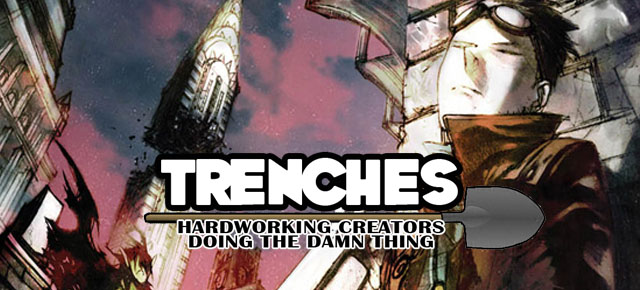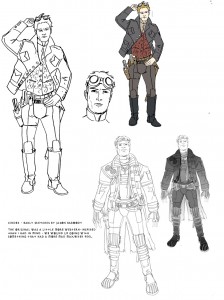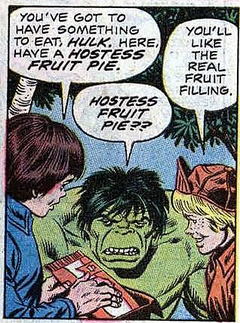What Counts, With Page Counts
 I’m closing in on finishing the script for Issue #1 of Gutter Magic, and I thought I would take the opportunity to talk a little about page counts – what and why the standard page count is 22 pages, and what that means to an indie creator like myself. I’ll also let you know what I decided to go with in the end.
I’m closing in on finishing the script for Issue #1 of Gutter Magic, and I thought I would take the opportunity to talk a little about page counts – what and why the standard page count is 22 pages, and what that means to an indie creator like myself. I’ll also let you know what I decided to go with in the end.
When I first started writing comics, page count was a little confusing to me. I knew that a story could be as long or as short as it needed to be, but I kept hearing and seeing how the standard script length was 22 pages. This didn’t make a lot of sense to me at first, because coming from a print production background, I knew that the page count on saddle-stiched books, like comics and magazines, needed to be divisible by four to avoid having blank pages. So, I went and counted the pages of some actual comic books – A-HA! They’re 32 pages! Not 22.
For an answer on why 32 pages is the standard, we have to look to the offset printing process, which is how all comics were made before digital printing became a viable alternative. In offset printing, the pages are printed on one huge, double sided sheet of paper and then cut. For comics, the magic number for the amount of content they could fit on one sheet turned out to be 8 spreads. Each double sided spread is 4 pages of comic, and 8 x4 =32!
So, what’s on the 10 pages that are left over? If you’ve ever read a book by Marvel or DC, you know the answer: ADVERTISING! Gone are the days of tiny ads for X-ray glasses, or offers to sell GRIT magazine door to door. Now, we’ve got huge, double page spreads for video games, movies, TV shows and action figures. The ads are bigger, and more attractive now, but they still serve the same purpose as having the Hulk make the world safe for Hostess Fruit Pies… they offset the cost of printing by bringing in revenue.
As an indie creator, you should ask yourself a couple of things. Are you planning to sell ad space in your creator-owned comic? Is Nike beating down your door to get a full page ad in your
Adventures of Superguy one-shot? If so, great. Anything you can do to stem your production costs will help you in the long run – a lot of Print-On-Demand outfits, like Ka-Blam, will even
offer you a reduced printing cost for running an ad for their service in your book. Still, convincing advertisers to spend money on a product with the limited reach of a typical indie comic is going to be a hard sell.
So, what are you going to do with all those extra pages?
There are a couple of options. First, lets assume you have a 22-page script. Your first option, maybe the easiest, is to ditch the 32-page model and just print a 24-page book. Depending on your printer, it will probably work out to be cheaper per copy than a 32-page book, and you only have 2 extra pages to fill. However, for the purposes of this discussion, lets assume you’re going with 32 pages.
You can fill those extra 10 pages with backmatter – prose pieces, script pages, sketches, pinups- these are all things that can give people a broader appreciation for your work. If you’ve got a huge, complicated backstory that keeps clunking your narrative, you can move all those infodumps here, either in a straight up descriptive piece, or a work of in-universe fiction, like the newspaper articles in Watchmen.
You can also let people on the nuts and bolts of your creative process by putting in sketches, script pages, or concept art – especially if you have designs that you’re particularly proud of. Pinups are great eye-candy – and a great way for writers to build relationships with artists that might blossom into more down the road – if you can get an artist to commit to a pinup now, maybe you can get a cover out of them next time – or some sequential pages.
Your next option is to just ditch the idea of sticking to 22-pages. Go for 26! Go for a full 32! It’s your book, and your choice to make. It can even be a selling point – if you’re charging the same amount of money that DC is charging for a Superman book, you can make the point that you’re giving your readers more story than they are – it might not help with every sale, but there are lots of people out there that absolutely hate the fact that ads are crowding out story pages in mainstream comics – the standard 22/10 split was actually 24/8 in the ‘90s. Some high-circulation books today are putting in even more ads, making for a 20/12 split, or even 19/13 for some issues.
The one thing you need to be careful with when expanding your page count is pacing – don’t just tack on a scene because you have the room. Instead, look for places where the story could use a little time to breathe, and expand there. The point is, the space is there if you need it.
The third option is to go ahead and put some ads in – for books of fellow indie creators. Try to work out ad-swaps – you get an ad in my book, I get an ad in yours. It’s a good way to build exposure for everyone involved, and a great way to build relationships with other creators.
So, after all that, what did I do with Gutter Magic? I still have a couple of passes to do, editorially, but the script’s sitting at 26 pages. There were some scenes where I felt I could use some more room to play around, so I took them. I also feel that giving the reader more story for their money is a good thing. I haven’t decided how to fill out my final 6 pages yet, but I have a lot of backstory and ideas that could easily fill it.
I hope that helps any other creators trying to puzzle out page counts for their own projects. The thing to remember, in my opinion, is that if and when you get to the bigs, you’ll likely be asked to do 22-page scripts, so its very valuable as a writer to nail down the pacing for a 22-page story.
However, if it’s your book, it’s your show… break the rules while you still can.
***
Rich Douek is a comic writer, and creator of Gutter Magic, an urban fantasy comic. Rich recently debuted a Gutter Magic one-shot at NY ComicCon, and is currently developing a miniseries featuring the same characters. He blogs about his comics, and writing in general at sixguncomics.com.
Related Posts:
Category: Trenches




















The ad swap idea is great, but for somebody who is just starting out and publishing their first book… I’m not sure who to even ask about swapping ads.
Does anybody have any ideas, or perhaps know of any communities that I could solicit some ad swaps in?
Good question and similar problem for people in other fields (e.g. business, film). I’ve found many like-minded creators via Twitter and Instagram. Look for people who have allied sensibilities and, above all, are easy to communicate with and are good human beings. If you get a good vibe from first connecting, then that’s a good sign. Build rapport, get to know them, see if you can see eye to eye.
Then I’d start talking business once you establish that you can communicate well. Don’t jump to business right away. Relationships are key and will help you in the long term. Keeping all questions and issues clear and in the open will help the relationship build to good collaboration.